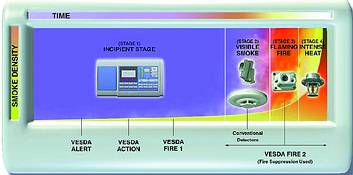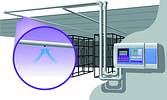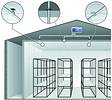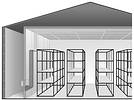
From processing and packaging to storage and delivery, refrigerated warehousing is an essential link in any distribution and supply chain.
These business-critical, temperature controlled environments accommodate a diverse range of inventory from fresh and frozen foods to pharmaceuticals and pre-packaged product lines. As markets continue to demand high quality product and efficient supply channels, any cold store business recognises the importance of protecting their facility and stock assets from the threat of fire.
With an operating temperature typically ranging from 80°C to -400°C, conventional 'passive' smoke detection systems do not reliably function or operate in extreme cold store environments. Their design, electrical components and reaction response do not provide proactive smoke detection in the event of fire. In some countries, national fire standards further state that, unless specified, smoke detectors should not be installed if the operating temperature is below 0°C (NFPA 72). Although widely utilised in warehouse facilities, sprinkler systems are generally inappropriate in freezing temperature conditions.
It may be hard to believe that a fire could occur in a cold store. However, factors such as an ultra dry atmosphere, and the highly combustible nature of polyurethane or polystyrene foam insulation, wooden pallets and plastic wrapping present a high fire risk in these environments. Additionally, electrical faults from conveyor/transport equipment, lighting, or hot spots caused by maintenance operation can also contribute to this risk. The holding capacity of a cold store demands specialised high volume storage racking, which can affect the airflow and impede the detection and response to a fire event. The best way to avoid a serious cold store fire is to install an aspirating 'active' smoke detection system.
One such aspirating system is VESDA which provides protection against fire by detecting the presence of smoke at the earliest possible stage (Figure 1).

VESDA detects smoke by cumulatively drawing and analysing air from the protected area and its very early warning minimises the likelihood of product contamination, facility and asset damage and distribution downtime.
VESDA provides detection in extreme low temperature environments by actively sampling air from a protected area via multiple sampling holes in a pipe network. The air sample is then transported to an externally located smoke detector for accurate analysis (Figure 2).

By locating the detector in an external, easily accessible area, its remote monitoring capability is able to provide smoke detection in areas with maintenance and access difficulties.
Pipe network
VESDA's pipe network can achieve a coverage of up to 2000 m2 per detector and its system flexibility is adaptable to any cold store configuration. In addition to its smoke detection capabilities, VESDA's programmable alarm thresholds allow a staged level of response to an escalating fire condition. This innovative system feature, combined with VESDA's filtration technology and advanced learning capabilities, provides for an early detection of a fire, eliminates the occurrence of nuisance alarms due to condensation clouds, and ensures low maintenance cost in these harsh environmental conditions.
Performance-based design
Performance-based design determines the best fire protection system by assessing the environmental risks at the concept design stage, ie the internal and external environment, smoke source, smoke movement, heat transfer and smoke detection within the structure. VESDA's performance-based detection technology complements existing cold store operations of continual refrigeration, humidity control, automated processing system and storage configurations. In addition, VESDA's design flexibility provides a secure environment for a facility's individual layout of freezers, chillers, anti-rooms, loading bays and plant/maintenance areas.
Cold store installation scenarios
Typically, cold stores are constructed within a warehouse style structure (Figure 3).

Many industry standards require the installation of smoke detection at both the ceiling level, and in the ceiling void area of the cold store. By positioning VESDA outside of the refrigerated area, the detector remains unaffected by the internal sub-zero temperatures. The air sample is cumulatively drawn from the protected area, raised to a minimum sampling temperature and then transported to the external detector for accurate analysis (Figure 4).

For further details contact Brett Birch, Aritech on tel: 011 805 1590.

© Technews Publishing (Pty) Ltd. | All Rights Reserved.